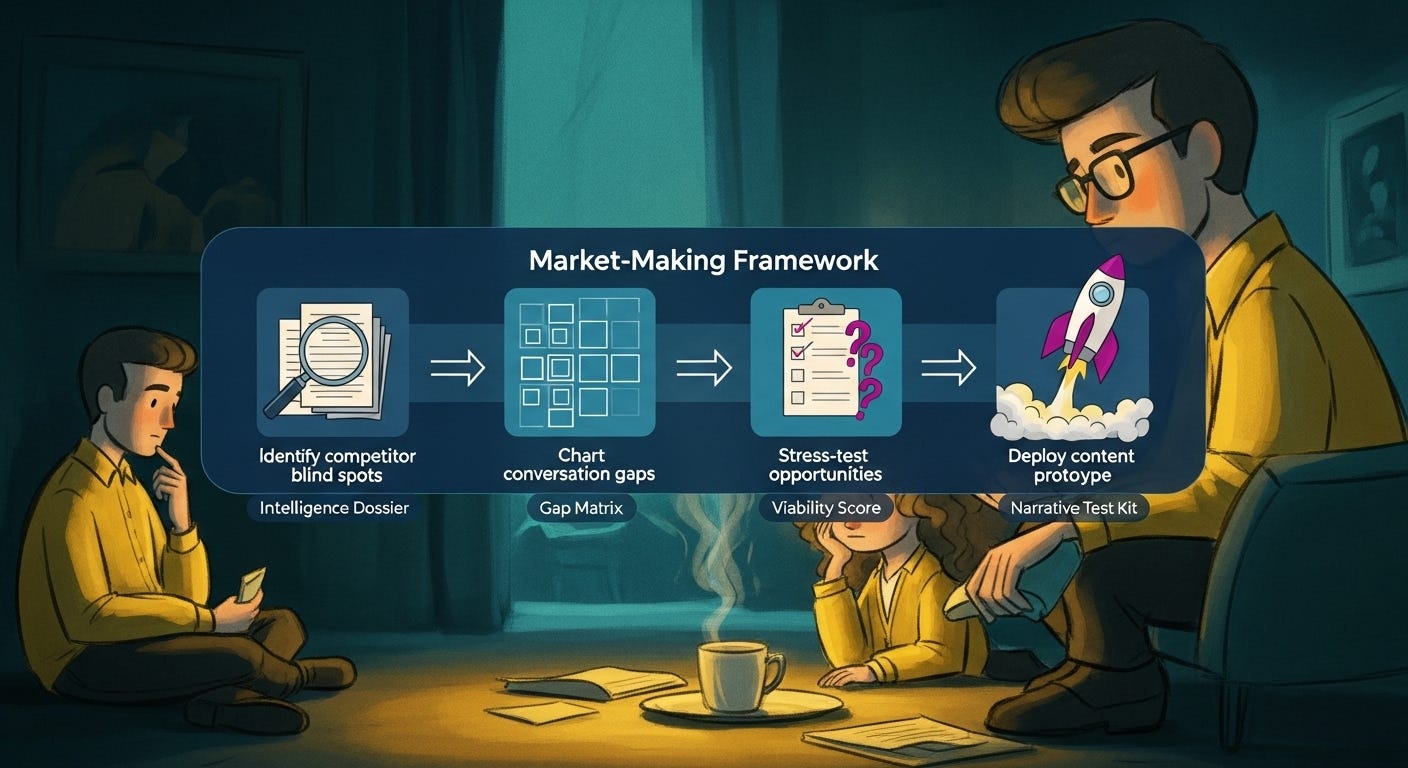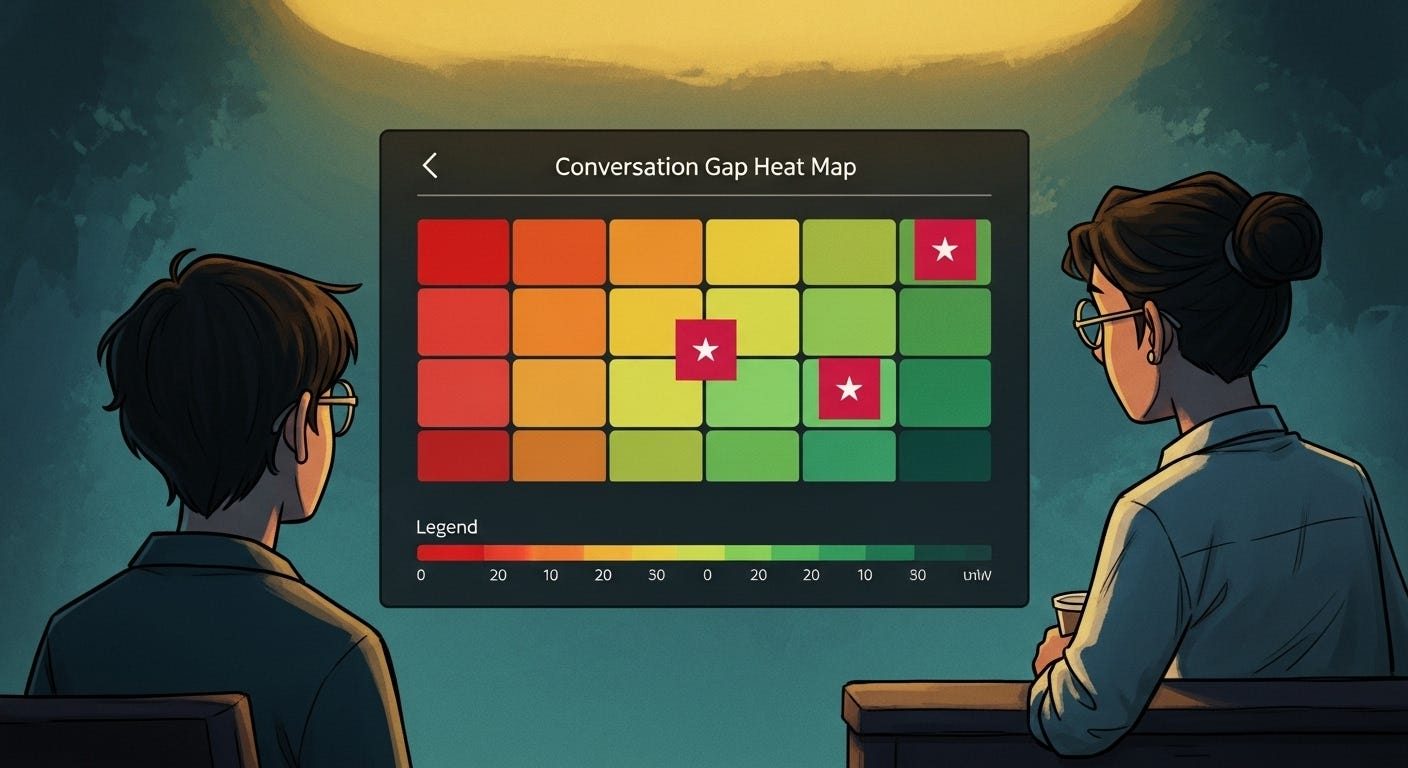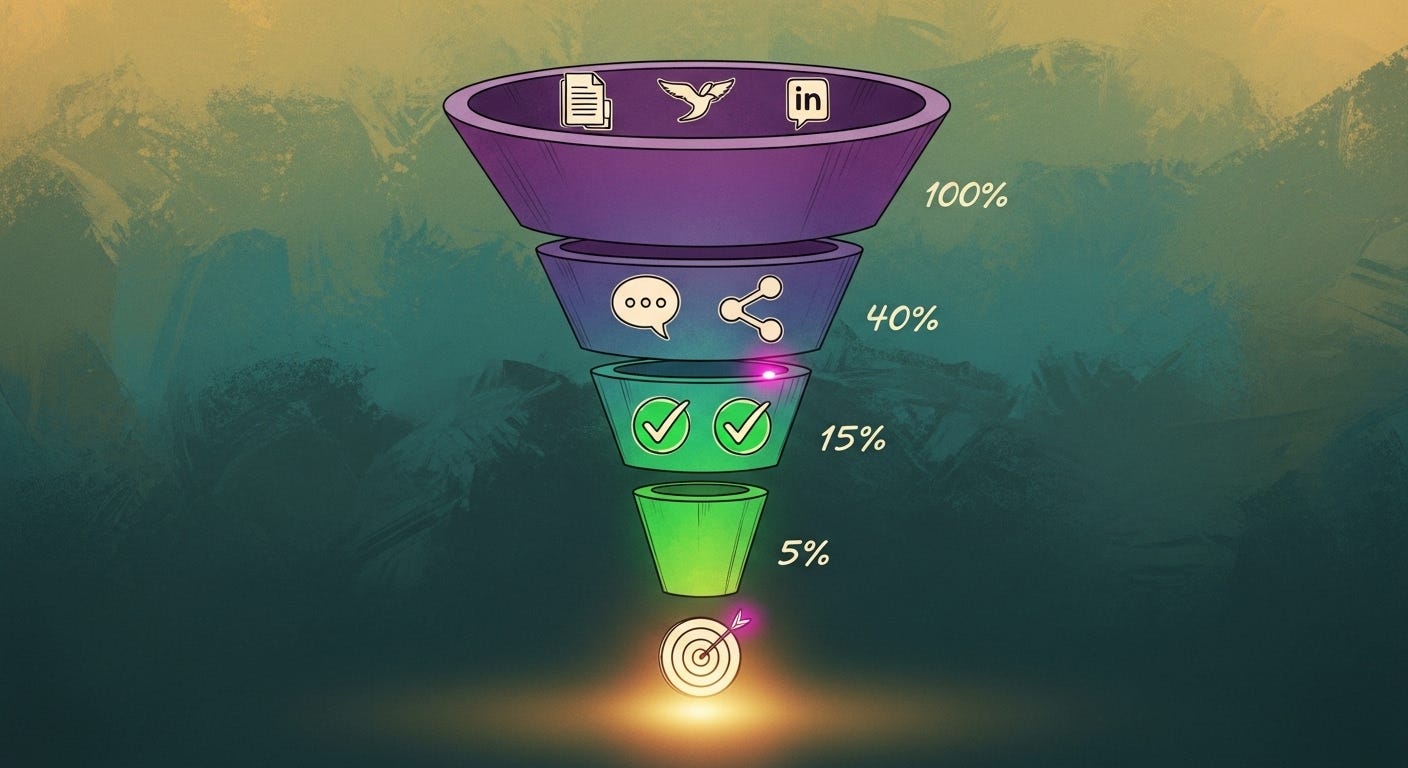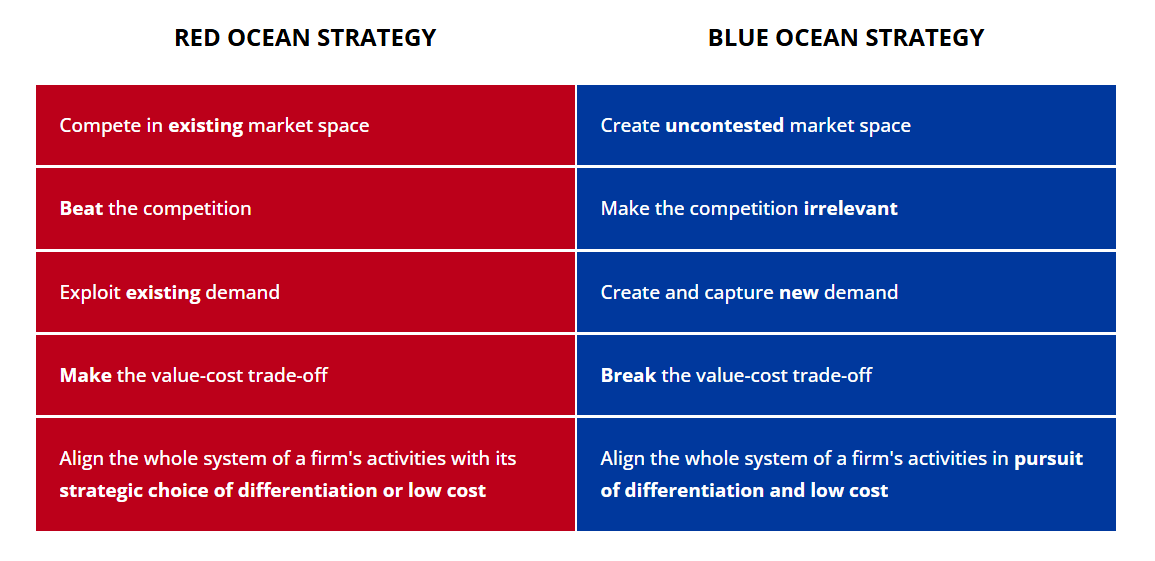An AI that's trained on best practices will never find the dragons
How to escape the "faster, cheaper" trap by using AI for category creation instead of content creation.
Welcome to today’s edition of ROBOTS ATE MY HOMEWORK. Today we’re going hunting for dragons. Or, more accurately, the places on the map where dragons used to be.
Medieval mapmakers sometimes marked unknown territories with fantastical creatures.
One famous example: the Hunt-Lenox Globe from 1510 bears the Latin inscription HC SVNT DRACONES - ’Here be dragons’ - off the coast of Asia.
Whether it was common practice or not, the image captures a powerful truth: the blank spaces on the map represent opportunity, not just danger.
It’s a declaration of ignorance, but it’s also an invitation. The dragons are an opportunity.
And that’s exactly where we are right now.
Most marketers use AI as a tool to copy existing maps better, faster, and cheaper. We are going to use it to find the blank spaces and draw our own maps.
We’re going to go where the dragons are.
Here’s what’s in it for you today:
A four-step framework for using AI to find the content gaps your competitors are too scared to touch.
How to build a spreadsheet that reveals these conversation gaps at a single glance.
A psychological bias you can exploit to make your creative workflow more powerful.
The business book you must read on this topic, and the one company that proves its entire thesis.
🤖 ROBOT REPORT CARD
The business world is obsessed with best practices and I’ve come to believe it’s a comfortable lie.
Best practices are where originality goes to die. They are the collected wisdom of yesterday’s winners, handed to you as a formula for becoming a faster second.
The only way to build an advantage is to create your own playbook, and AI is the perfect tool for the job.
This is the system for market-making.
In a nutshell, you’ll build this sequence:
Prompt 1 → You analyze competitor content and identify what they’re not talking about.
Prompt 2 → You organize those findings into a matrix and spot specific gaps/opportunities.
Prompt 3 → You pick your best gap and run it through 10 challenging questions.
Prompt 4 → You use that validated gap to create test content.
Let’s get right into it ⬇️
Step 1: Define your “profitable pond”
First, you need to analyze your competitors to find what they ignore.
Your goal is to discover the conversations they are actively avoiding, as this is where the market opportunity lies. This requires moving beyond a simple keyword analysis and deconstructing their entire worldview.
You’ve got to get inside their head and understand how they actually see things and what’s shaping the way they think.
Here’s the process:
Gather your intel: Collect the URLs of your top 3-5 competitors. You want their primary blog/content hub, their social media profiles (for Twitter/LinkedIn, you may need to save recent posts to a document) and links to their top 3-5 most popular articles or podcasts.
Use a research-focused AI: This is a perfect job for a tool like Perplexity (or ChatGPT Plus, or Claude API, or Google Gemini’s URL context tool), which can analyze content from URLs. You will use it to create a dossier on each competitor.
Execute the prompt: For each competitor, feed the collected intelligence into your AI assistant. Think of yourself as performing a forensic analysis.
You are a competitive intelligence analyst specializing in strategic narrative deconstruction. Your job is reverse-engineering the mental models, strategic bets, and market beliefs embedded in competitor content.
Analyze the provided URLs through these lenses:
1. Strategic silence analysis
What problems exist in this space that they refuse to acknowledge? Identify 3-5 market realities, customer pain points, or industry debates they’re conspicuously avoiding. For each gap, hypothesize why (lack of solution, strategic weakness, different market bet, or ideological stance).
2. Narrative evolution tracking
How has their messaging shifted over time? Compare older vs. recent content to detect pivots in positioning, dropped narratives, or emerging themes. What does the evolution reveal about failed bets, market pressure, or strategic repositioning?
3. Belief System Archaeology
What core assumptions underpin their entire content universe? Extract the unstated beliefs about:
- How the market should work
- What customers should prioritize
- What problems matter vs. don’t matter
- Where the industry is heading
Then stress-test each assumption: where do these beliefs break down?
4. Sophistication gradient mapping
Chart where they oversimplify vs. where they add nuance. Does technical depth appear only in certain formats or for specific topics? This reveals what they consider defensible IP vs. commodity knowledge.
5. Rhetorical moves & manipulation tactics
Identify their persuasion patterns:
- What objections do they pre-empt?
- What alternatives do they strawman?
- What social proof signals do they deploy?
- What urgency/scarcity frames do they use?
6. Content activation signals
What actions do they actually want readers to take at each funnel stage? Distinguish between stated CTAs and implied behavioral prompts. Where does content activate vs. just educate?
7. Competitor’s ideal customer reconstruction
Build a psychological profile: What does someone need to already believe, value, or fear to find this content compelling? What’s the “before state” persona they’re targeting?
Output format: Specific examples with direct quotes. For every insight, cite the exact URL and passage that revealed it. Prioritize non-obvious findings—anything you could learn from a basic keyword scan doesn’t countThis prompt adds temporal analysis (how strategy evolves), psychological deconstruction (belief systems), and activation mechanics (behavioral intent), which standard competitive analysis misses.
Repeat this process for each competitor. The output is a rich intelligence document that reveals your competitors’ complete playbook: what they talk about, how, and why. It also reveals the strategic ground they have unconsciously surrendered.
This is your hunting map for dragons.
Step 2: Identify the “conversation gaps”
Now you will synthesize the AI’s analysis into a single source of truth. Create a “Conversation Gap” analysis table. It’s simpler than it sounds and brutally effective.
Create a spreadsheet with these columns:
| Topic Cluster | Comp A Blog (Depth Level) | Comp A Social (Angle) | Comp B Blog (Depth Level) | Comp B Social (Angle) | Channel-Topic Mismatch | Strategic Gap (Your Play) |
Depth levels: Surface/Educational/Tactical/Strategic
Angles: Promotional/Thought Leadership/Engagement/Community
‘Channel-Topic Mismatch’ - reveals where competitors discuss topics in the wrong format—a strategic blind spot.
Now, populate it. Have your AI analyze the content from your competitors.
You are a strategic content analyst specializing in competitive discourse mapping.
Task: Analyze the provided competitor content and construct a conversation gap matrix.
Step 1: Extract Topic Clusters
Identify 8-12 distinct topic clusters across all content. Don’t just list surface topics—identify the underlying strategic themes (e.g., not “AI tools” but “democratization of AI for non-technical users”).
Step 2: Channel-Depth Analysis
For each competitor and topic cluster, document:
- Presence: Is this topic discussed on blog, social, both, or absent entirely?
- Depth Rating: Surface mention (1), Educational overview (2), Tactical implementation (3), Strategic positioning (4)
- Messaging Angle: Are they selling, educating, building authority, or fostering community?
- Frequency: Occasional, recurring, or pillar content?
Step 3: Pattern Detection
Flag these specific mismatches:
- Topics present on blog but sanitized/absent on social (reveals discomfort or complexity concerns)
- Topics hyped on social but lacking blog depth (engagement bait without substance)
- Topics mentioned once then abandoned (failed positioning attempts)
- Adjacent topics completely ignored across all channels (strategic blind spots)
Step 4: Gap Categorization
For each identified gap, classify the opportunity type:
- Underserved: They mention it but don’t go deep enough
- Avoided: Obvious topic they’re actively sidestepping
- Abandoned: They tried it, then stopped
- Unsophisticated: They oversimplify where nuance would differentiate
- Channel-orphaned: Discussed in wrong format for the audience
Output requirements:
- Cite specific content examples with URLs
- Quantify content volume per topic (number of pieces)
- Include direct quotes showing their framing
- Provide hypothesis for why each gap exists (capability limitation, strategic choice, market positioning)Feed the AI your competitor data. The output will help you fill the columns.
You will quickly see patterns.
Maybe everyone talks about “Productivity” on their blogs, but only one competitor mentions it on social media.
Maybe no one is talking about the cost of low productivity. That silence is interesting. That’s a potential dragon.
For my own product, Yahini, this exact process was a complete game-changer. Our competitors were all shouting about “AI content creation.” We fed their blogs and social posts into an analyzer.
The gap was an entire stage, not a keyword. Literally nobody was talking about the strategic work that happens before you write a single word with AI. They ignored the research, the keyword analysis, and the outlining.
That silence was our dragon. We built our entire category, “AI Content Strategist,” in that gap.
Step 3: The interrogation
Not every silence is an opportunity. A topic might be ignored because it’s commercially worthless, operationally impossible to own, or your competitors already tested and abandoned it.
Before committing resources, systematically stress-test each gap using both internal critique and external validation.
Pick your most promising gap and run it through this multi-layered validation framework.
Adopt the mind of a ruthlessly skeptical business strategist and market analyst. I’ve identified a conversation gap: [State the specific gap clearly].
My hypothesis: This represents a differentiation opportunity worth pursuing.
Your mission: Interrogate this hypothesis from multiple angles to expose weaknesses before I waste resources.
Part 1: Fundamental Viability Questions
Challenge the gap’s basic logic:
- Customer Pain Validation: “What specific, measurable pain does this solve? Can customers articulate this problem without you explaining it first?”
- Competitor Intelligence: “Why has the competition avoided this? List three legitimate strategic reasons they might be right to ignore it (lack of monetization, legal/compliance issues, customer indifference, technical impossibility).”
- Credibility Assessment: “What proof points do you have (or need) to be seen as the credible authority here? If a customer asks ‘why should we listen to you about this?’, what’s the answer?”
- Belief System Mapping: “What fundamental worldview must someone hold to care about this gap? How large is that audience segment?”
- Revenue Mechanism: “Trace the direct path from ‘owning this conversation’ to revenue. Be brutally specific—how many touchpoints, what conversion assumptions?”
Part 2: Competitive Reality Check
Test against market dynamics:
- Execution Barrier Analysis: “What resources, expertise, or assets would you need to own this position that you don’t currently have? How long to acquire them?”
- First-Mover Risk: “Is this gap ignored because the market isn’t ready yet? What signals would prove timing is right now?”
- Substitution Threat: “Even if competitors aren’t addressing this directly, what alternative solutions already exist? Why would someone choose your approach?”
Part 3: Strategic Fit Assessment
Evaluate alignment with your business:
- Authenticity Test: “Does this gap align with your actual capabilities and brand positioning, or would owning it feel forced?”
- Opportunity Cost: “What are you not doing if you pursue this? What higher-ROI alternatives exist?”
Output format: For each question, provide a 1-5 score (1 = major red flag, 5 = strong green light) with specific reasoning. Then calculate an overall viability score and recommend: Pursue, Pivot, or Abandon.Your ability to answer these questions determines if you’ve found a puddle or a deep, profitable pond.
Step 4: Prototype your position
An idea is worthless until it survives contact with the market. Your first job is to test your new worldview, not your product.
Use minimum viable content to test whether the worldview resonates, not whether the copy is clever.
Mega Prompt:
You are a category creation strategist. My company: [brief description].
Based on our gap analysis, we’ve identified this conversation gap: [state the gap].
We’ve validated it by confirming: [1-2 sentence summary of your answers to the “so what” questions—basically why this gap matters and why you can own it].
Create a “Narrative Test Kit” with these assets:
1. Contrarian Blog Post
Title formula: Challenge the status quo directly (e.g., “Why [Common Practice] Is Killing [Outcome]”)
5-point outline structure:
- Current broken approach (with specific pain point)
- Why it persists (expose the flawed assumption)
- The reframe (introduce your new lens—give it a name)
- Evidence (2 examples where this lens reveals what others miss)
- The shift (what becomes possible with this view)
2. Twitter Thread (5 tweets)
- Tweet 1: Bold, data-backed claim that contradicts conventional wisdom
- Tweets 2-3: Break down the failure of the old way (make it visceral)
- Tweet 4: Introduce your framework without pitching product
- Tweet 5: End with validation question: “Am I alone in seeing this?”
3. LinkedIn Contrarian Post
- Format: “I’ve noticed [pattern] across [X] companies. Here’s what nobody’s saying...”
- Structure: Observation → Hidden cost of ignoring it → Hint at alternative approach
- Call-out the “emperor has no clothes” moment in your industry
- End with invitation, not assertion
Tone: Confident but curious. Challenge ideas, not people. Use “we” not “you.” The goal is to spark “finally, someone said it” reactions, not applause.Deploy this test kit. Watch the comments. See which posts get shares.
A single comment that says, “Finally, someone is talking about this,” is worth more than 100 empty likes. It’s a signal that you’ve found the edge of the map, and there are people there waiting for you.
💡 A NEW CONCEPT FOR YOU
Ever start a puzzle and find yourself obsessed with finishing it? That’s the Ovsiankina Effect - your brain’s built-in hatred of unfinished business.
Hemingway knew this. The legend goes that he’d stop writing mid-sentence at the end of each day.
Mid. Sentence.
That unresolved tension would haunt him until he sat back down the next morning, desperate to finish the thought.
Here’s how you can weaponize this for market strategy.
The “Conversation Gap” analysis I just described is complex work. It requires deep thinking. And honestly, the worst thing you can do is try to finish it in one marathon session.
Instead, apply the Ovsiankina Effect.
Fill out half of your spreadsheet. Identify a few potential gaps, then stop. Close the laptop. Go for a walk.
Your brain will not stop working. The unresolved tension of the empty cells will gnaw at your subconscious. It will continue connecting the dots, looking for patterns in the silence.
When you come back (and you will come back), you’ll have clarity you couldn’t have forced. Ideas you didn’t know you had.
So, my advice is this: Don’t just work on your strategy. Let your strategy work on you.
✨ ONE MORE THING...
The overarching theme of everything I’m talking about today has a name: Blue Ocean Strategy. It’s the title of a phenomenal book by W. Chan Kim and Renée Mauborgne.
Their core idea is that most companies compete in “red oceans” full of sharks, fighting over a shrinking pool of customers. The alternative is to create “blue oceans” of uncontested market space.
It’s the academic framework for hunting dragons.
If you want to see a perfect example of this in the wild, look at the company Gong. They didn’t enter the crowded red ocean of “sales analytics.” They created a blue ocean called “revenue intelligence.” They used their customers’ own language to define a new category that made the old one feel obsolete.
Read the book.
Study the company. Then go find your own blank space on the map.
So, here’s my question for you:
What’s one “best practice” in your industry that feels like complete bullshit?
To drawing your own maps,
Chief 🤖 at ROBOTS ATE MY HOMEWORK
🐉 My analysis suggests a >90% probability you will find these articles valuable as well:












I absolutely love how actionable this in. Thank you so much for utterly wrecking my plan for the day! I had it very structured with clear goals that I have now thrown out the window because this has my brain desperate to try it out and I can just imagine now the rabbit hole I am going to fall into... how marvellous!
I started with the first prompt for my industry and I am blown away. Using the Hemingway technique to take time away and write this note because there was so much to process in just the first part. I used Perplexity to grab all the links for competitors and the first prompt. Going to move the rest over to Claude since it works really well with spreadsheets.
Can't wait to see what else I uncover through the remaining prompts. Thanks Mia!